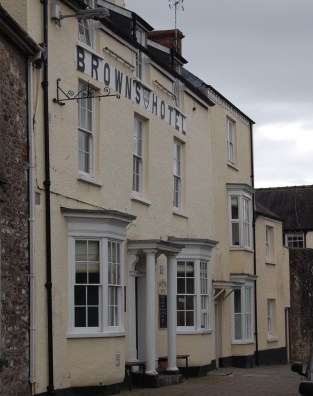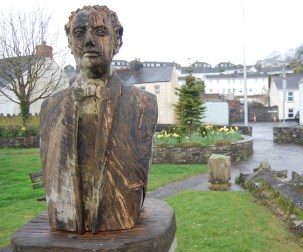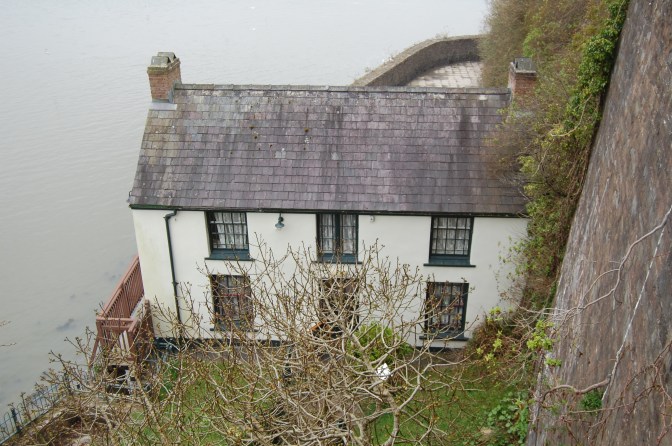As a child, about 13 or 14 years old, I would sneak books from my father’s library to read in my room. I didn’t ask to borrow them (permission would have been granted enthusiastically) and I never told my teachers what I was reading at home, I just took them away and enjoyed them in private. Reading for me has always been a solitary activity: a way to escape from the world and, besides, I was rather an odd child. The writers that stand out in my memory from this time are Dickens, Steinbeck, Hemingway and Dylan Thomas. I loved Thomas’s stories then and love them still: Holiday Memory, Quite Early One Morning and, particularly, A Child’s Christmas in Wales. I have since added Under Milk Wood and Portrait of the Artist as a Young Dog to my list of favourites. A visit to his home town is always a special event for me.

Brown’s Hotel was Dylan’s favourite pub and he would spend most afternoons here, drinking and sitting in the bay window, watching passersby: an endless stream of fascination for a poet who loved to create unique characters. Brown’s has recently reopened as a boutique hotel. I was reading about this online recently when I noticed that they do a special midweek offer of 2 nights for £145. As a teacher, money is tight at the best of times but no Dylan Thomas fan could resist a deal this good: to stay at his favourite pub in his home town with nothing to do but eat & drink, walk & read for two whole days. I booked and early one April morning, Mrs. P and I took the journey across country to the far west. Brown’s is a fine little pub that serves a decent local ale and has a selection comfortable and well-decorated rooms with excellent facilities, including a small selection of decent books. The corridors are decorated with artwork depicting the town and inspired by its favourite inhabitant and the rooms are all named after inspirational places for Dylan: Fern Hill, Talacharn, Uplands etc. We stayed in ‘Llareggub’ and were very pleased to do so.
Laugharne (pronounced ‘Larn’) was described by Dylan as “the strangest town in Wales” after his first visit there. It is a beautiful place and (at least midweek in April) it is quiet, peaceful and friendly. On our first evening there, Mrs. P and I eschewed the restaurant and went for a wander. There were very few people about but those we did see smiled and nodded. A group of small boys played with a rugby ball outside the Castle View chip shop. Coming from the South-East of England, I am used to seeing small boys kicking footballs about; it’s part of our national landscape but rugby balls? never. In the warm spring twilight with the distant sound of the sea, this struck me as the most ‘Welsh’ scene I had ever witnessed. We ate fish and chips on a picnic bench beneath the castle walls in the chilly twilight – we know how to live, Mrs. P and I. We watched the light fade over the Taf estuary while starlings swarmed (‘murmurated’?) above us. The occasional dog walker passed but we were mostly alone. There is a path alongside the estuary that leads towards the boathouse and we walked along it now, looking at the houses on the cliff above us and watching the lights come on in little villages across the river.

In the morning, following my excellent, home-cooked full Welsh breakfast (very similar to a full English but includes cockles and laverbread, which I tried because I was feeling particularly brave that morning), I went for a wander up the hill to the church while Mrs. P. stayed at the hotel. It was raining quite steadily as I set out but I wasn’t far into my journey when it relaxed into a light drizzle. I don’t mind walking in drizzle and no one wants to visit a churchyard in bright sunshine anyway. It is one of the most atmospheric churchyards I have ever walked around: mossy pathways snake through the hillside and a bewildering array of lichens cling to the crumbling tombstones. To reach Dylan and Caitlin’s grave, you must cross a footbridge into a ‘new’ cemetery, where graves are arranged in ordered rows. Dylan’s grave stands out among them as it is a simple, plain white cross. He was brought here in 1953 after his untimely death in New York. The legend is that he dropped dead in the Chelsea Hotel after a particularly heavy drinking bout, uttering the famous words: “I’ve just had eighteen straight whiskies; I think that’s a record!” The truth, as with all legends that grow around great people, is quite different and it seems he was being incorrectly medicated and – having been advised not to drink – fell into a coma from which he never recovered, finally dying of a brain haemorrage. Caitlin also died abroad in 1994, having lived in Italy for most of her life since Dylan, unable to stand living in Laugharne without him. Their relationship was a tempestuous one, marked by infidelity and jealousy; alcoholism and violence. They were kindred spirits: both bohemian and artistic, neither of them could keep the other grounded and the result was a passion born of both love and hate. She requested in her will to be buried alongside him in Laugharne.
Dylan first settled in Laugharne after his marriage to Caitlin Macnamara in 1938. He first met her at the Wheatsheaf pub in London. she was with her bf, the artist Augustus John. Dylan wooed her away from him and they embarked on a relationship that would last until his death just 15 years later. They rented a small cottage (called ‘Eros’) before moving into Sea View, a three storey Georgian townhouse. They were always poor. Dylan lived off the proceeds of his poetry and what little income he could earn from radio broadcasts. The lecture tours of America (he did three of them) helped to supplement his income but, for most of the time, the Thomases relied on handouts and lived in debt. It was partly to escape this debt that they fled Laugharne in 1940.

Dylan’s presence is everywhere in Laugharne but he is treated with reverence, not exploited for tourist money. There are no Dylan Thomas tearooms or Milkwood gift shops. The tea room where I met Mrs. P for a morning coffee was a very pleasant one. Called the Owl and the Pussycat, it is adorned with owl and cat pictures and ornaments, does a wonderful coffee and has a huge range of home-made cakes on offer. We finished our morning repast and went next door to the craft shop. Dylan has asserted his presence here but the wares on offer are tasteful and genuine. And I liked the owner very much: she was friendly and chatty and laughed at all of my jokes, which is a rare experience for me and I was quite taken aback. Mrs. P and I spent an hour or two walking along the shore: chatting, spotting wildlife and looking for interesting stones. By now, the rain had stopped completely, the sky was clearing and the sun was beginning to break through, turning the picturesque little town into an achingly beautiful one, basking in the golden spring sun.
The laverbread was still providing me with a persistent reminder of breakfast, so I forwent lunch and walked instead along the heavily wooded cliff-top path that leads to the boathouse. “My sea shaken house, on a breakneck of rocks”, the boathouse hugs the bottom of the cliff by the estuary. Inside is a nice, quiet little museum. the house itself is tiny for the home of an internationally famous writer. The parlour on the ground floor has been restored to how it would have looked when Dylan was living there. It is cosy and comfortable and a radio plays selections from Dylan’s readings. You are invited to sit and listen and contemplate your surroundings, which I did. There was a fair stream of visitors coming through, considering the town itself was all but deserted. The upper floor has two rooms, one of which has an exhibition room, with books and letters and other documents in Dylan’s hand, and an art gallery, featuring works inspired by Dylan’s poetry; in the other room a documentary film about his life and work plays on a continuous loop. The ground floor has a small tea room, where I had hoped to get tea and welsh cakes and read my newly bought books (they have a little bookshop here too). There were no tables available however, as it was crowded for their lunchtime service and it was too cold to sit outside, so I walked back along the path to have a look at the writing shed, where the poet would retreat to escape the distractions of family and work amid stunning views of the peaceful estuary. The shed has also been restored so Dylan would recognise it, and has his desk, in disarray with open books, screwed-up papers and coffee mug, as if he has just got up and left.

I had a quick look around the castle then. A dramatic, 13th Century fortress, guarding the once bustling port that brought to West Wales goods from throughout the world. The ramparts make the best viewing platform for the town and from here you can see the streets laid out beneath you. It is supposed that the town of Llareggub in Under Milkwood was based on Laugharne but, personally I can’t see it. There are some features you can recognise from the play: the town square and the wood on the hill in the distance but I think Llareggub more closely resembles the little fishing villages further to the west. New Quay fits the bill and Dylan did live there for a short time. The castle also has a summer house, in which Dylan used while he was staying at Castle House with Richard Hughes. He wrote ‘A Portrait of the Artist as a Young Dog’ there.
I met Mrs. P back at the café, where we had tea before returning to Brown’s and I finally got to read my guidebooks. I sat in Dylan’s window seat but it was particularly uncomfortable, so I found a more conducive corner in which to peruse my purchases, which I did over a pint or two of Brown’s ale. We ate at Brown’s that evening too: it was unfussy but good, simple food and I finished it off with a Penderyn Welsh whisky: an astoundingly good one that can hold its head high among many Scottish single malts. They sell it by the bottle … so I was able to pick up another souvenir. We left the following morning for Swansea to continue our Dylan pilgrimage. I was sorry to leave lovely, friendly little Laugharne. It could well be my favourite town; it certainly makes top three, along with Stratford-upon-Avon and Haworth, and it is more intimate; one feels at home here. It certainly is a strange town but its isolation and atmosphere call to mind Dylan’s later epithet, written 5 days before he died: “a timeless, mild, beguiling island of a town.”

Leave a comment